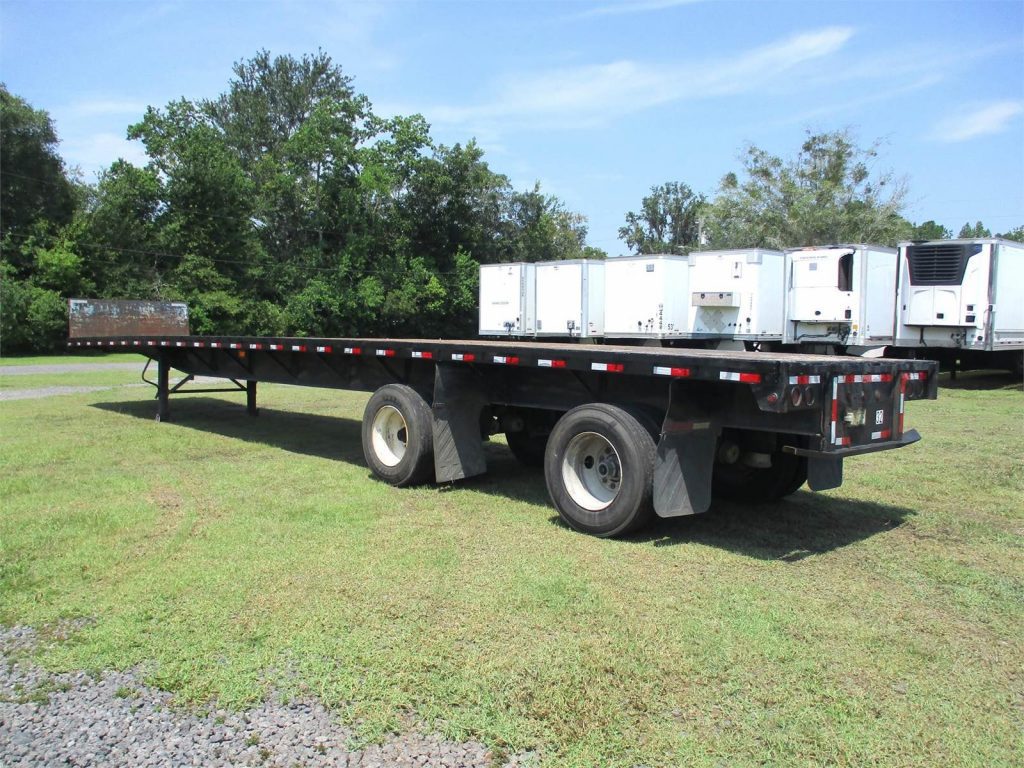When you’re looking at potential trucks to buy to help run your business or increase your fleet, you’re probably finding there are a lot of different trucks available. Especially if you’re considering purchasing a semi truck, you might have come across a lowboy trailer as well as flatbed trailers. But what’s the difference between a lowboy and a flatbed? We’ll answer this question, as well as describe what types of trailers are available. In the trucking industry, it’s critical to understand the answer to “What’s the difference between a lowboy and a flatbed?”, since they have different uses and capabilities. So, let’s start with what types of trailers are out there.

Types of Trailers
In the trucking industry, there are many different kinds of commercial trucks built for different purposes. Different cargo requires different modes of transportation, so it’s helpful to know the various types of trailers available and when best to use them. Here’s a short list of different types of trailers available:
- Dry vans
- Reefer trailers
- Utility trailers
- Flatbeds
- Lowboys
These four types of trailers are the major types regularly seen transporting cargo. Driving any one of these trailers (along with their cab) requires CDL certification because they are commercial vehicles. Each type of trailer also requires specialized knowledge for driving, maintaining, and loading the vehicle. Each trailer type has different carrying capacities and dimensions available.
Dry Vans
Dry vans are the typical box trailers that can carry a wide variety of cargo. They come in many different dimensions as well. Dry vans are enclosed and unrefrigerated. Dry vans are also typically easier to maintain and drive, as well as the cargo they can carry.
Reefer Trailers
Reefer trailers, or refrigerated trailers, are built to maintain a certain temperature the cargo requires. Cargo like food products and medications are usually transported on reefer trailers. Reefer trailers need to maintain the correct temperature in order to keep the integrity of the cargo, otherwise, the cargo can degrade or spoil.
Utility Trailers
Utility trailers are a large group of trailers made to do specific jobs. These trailers include dump trucks, tow trailers, cement mixers, and tanks that transport liquids or gases. As you can imagine, each type has specifications that make it better suited for a particular job.
Next, we have flatbeds and lowboys. So, what’s the difference between a lowboy and a flatbed? Let’s go into detail about the differences between these two.

Flatbed for Semi Truck
You might be wondering about the difference between a lowboy and a flatbed since they’re similarly shaped. Like a dry van, a flatbed for semi trucks can carry a lot of different cargo types and sizes. However, unlike a dry van, flatbeds are open air, whereas dry vans are enclosed and the cargo is placed within the carrier box. The openness of the trailer makes it easier to load and offload cargo compared to an enclosed dry van trailer. You have more access to the cargo as it’s on a flatbed for semi trucks during transit. Unlike a dry van, cargo on a flatbed for semi trucks requires extra tethering to ensure the cargo is secure. Cargo may also require the use of a tarp to protect the cargo since it’s on an open-air flatbed. Now that we’ve gone through the specifics of a flatbed, we’ll describe what a lowboy is and how it differs from a traditional flatbed.

What Is a Lowboy?
We’ve gone through dry vans, reefer trailers, utility trailers, and flatbeds. So, what is a lowboy? Unlike a flatbed which has consistent height off the ground, a lowboy has a section of the bed that is lower than the top of the bed. The well is usually in the middle of the bed of the lowboy (also known as a low-bed or low loader) with two sets of tires under the front and another set at the back raised portion of the bed.
Purpose of a Lowboy
When we’re describing the answer to “What is a lowboy?”, we have to go into the specifics of why a driver might choose a lowboy over a flatbed. The bed of a lowboy can be about two feet off the ground, which makes it ideal for transporting huge cargo, such as construction vehicles and equipment. If these vehicles or equipment were carried on a flatbed, it might exceed the maximum height limit for the journey, making it impossible to drive the truck under overpasses and street signs. This is why lowboys are ideal for transporting oversized cargo.
Because of their low height, lowboys can remain under the height maximum needed for a route. It’s also possible to load the cargo directly onto a lowboy, depending on the trailer. Lowboys do cost more upfront to use, but because they’re not as common as other trailer types, demand can be higher for lowboy drivers. It’s essential to know what kind of cargo you plan on transporting to determine if a flatbed or a lowboy is better for your business needs.
In this guide, we’ve described the difference between a lowboy and a flatbed. The main difference is the height from the ground and what kind of cargo they can carry. We also went through the major trailer types; namely driver vans, reefer trailers, and utility trailers, besides flatbeds and lowboys. Regardless of trailer type, you need to make sure you have your CDL certification. Then you start driving a commercial vehicle. Driving a flatbed or lowboy is a great way to earn income, including if your lease it out to other companies. Understanding the difference between a flatbed and a lowboy is critical for earning money in the trucking business, especially when you’re considering different cargo to transport.

